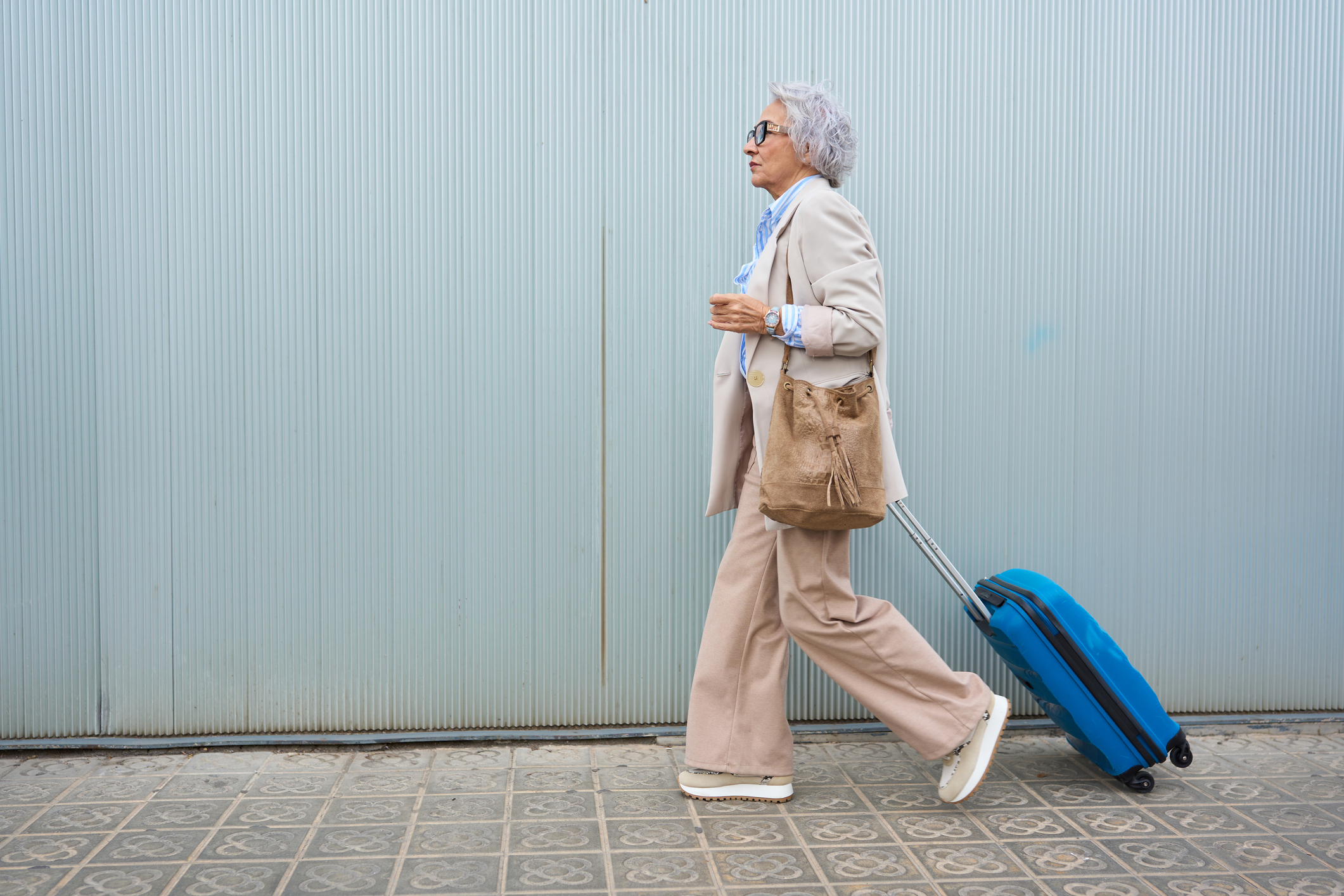Is Flying in America Still Safe? Navigating the Turbulence in U.S. Air Travel
With outdated systems and staffing shortages causing disruptions, here's what travelers need to know to stay safe and protect their plans.

If you’ve ever watched the news right before a flight, you might have seen stories about runway incidents, pilot shortages, even weather-related disruptions.
It’s enough to make anyone wonder if flying is still safe. While it’s easy to feel unsettled, the truth is that air travel remains one of the safest ways to get from point A to point B, especially compared with car travel.
A recent analysis by Osborne & Francis of data from the National Highway Traffic Safety Administration (NHTSA) found that October is the most dangerous month for drivers in America, with a staggering 17,543 fatal crashes nationwide over five years. August and September weren’t much better.
From just $107.88 $24.99 for Kiplinger Personal Finance
Become a smarter, better informed investor. Subscribe from just $107.88 $24.99, plus get up to 4 Special Issues

Sign up for Kiplinger’s Free Newsletters
Profit and prosper with the best of expert advice on investing, taxes, retirement, personal finance and more - straight to your e-mail.
Profit and prosper with the best of expert advice - straight to your e-mail.
So far in 2025, at least 87 people have died in a plane crash in the United States. The numbers don’t lie: Your odds of a fatal crash are much higher behind the wheel than in a window seat.
Air travel safety: The big picture
Planes are big, heavy machines that soar miles above the ground. It’s easy to feel as if any little hiccup could lead to disaster. Despite such challenges as staffing shortages and unexpected weather disruptions, U.S. airlines have managed to keep safety a top priority.
Regular maintenance checks, strict FAA regulations and technological advancements have all contributed to safer skies. When you look at the numbers, flying remains very safe.
According to the Federal Aviation Administration (FAA), U.S. commercial airlines have maintained a strong safety record in the past decade. That’s partly due to modern aircraft designed with cutting-edge technology to prevent accidents, as well as pilots who undergo rigorous training to prepare for every possible scenario.
However, recent air disasters have been particularly shocking due to their severity. One of the deadliest incidents in a decade occurred in Washington, D.C., when an American Airlines flight collided with an Army Black Hawk helicopter. Another crash on February 6 in Alaska claimed 10 lives.
According to the National Transportation Safety Board (NTSB) database, an average of 28 air carrier flights per year in the past 20 years have been involved in an accident or some level of “occurrence.
The number of accidents has fluctuated annually since 2005, with both 2005 and 2019 recording a high of 40 air carrier accidents, while 2020 saw the lowest number at 15.
Private flights significantly impact the NTSB statistics, as wealthier individuals tend to fly more during the summer months. These private flights are riskier because they're often piloted by less experienced individuals who might not be prepared for sudden summer storms.
Navigating airline disruptions and safety measures

If you’ve ever been stuck at an airport due to a “maintenance delay,” you know it’s frustrating. But those delays happen for good reason: Safety. The FAA enforces strict maintenance schedules, and airlines are required to follow them to the letter. Everything from engine checks to emergency equipment is inspected regularly.
Despite the planes being generally safe, the airline industry has been navigating some rough skies lately due to internal challenges that are impacting travelers nationwide. In recent years, staffing shortages have led to a surge in flight cancellations, delays and even compromised service quality.
Compounding the issue is a significant shortage of certified air traffic controllers. As of 2025, the FAA is operating with approximately 3,500 fewer controllers than needed, leading to increased workloads and potential safety risks.
The FAA handles more than 45,000 U.S. departing flights each day, and the number of air travel incidents we hear about are few and far between compared with those numbers.
Air travel vs. car travel: A statistical comparison
Here’s the part that surprises a lot of people. Statistically, car travel is much riskier than air travel. You’re far more likely to be involved in a fatal accident while driving than flying. It’s not a slight difference — it’s massive.
According to the Osborne & Francis analysis, October is the deadliest month for drivers, with more than 17,543 fatal crashes in five years. August and September aren’t far behind. Those numbers are shocking when you think about how common driving is vs flying.
The study also found that February is the safest month for drivers, with 12,412 fatal crashes. But even that number towers over the virtually non-existent fatalities in U.S. commercial flights.
However, with recent airline events making headlines, along with rising costs among major airlines, many people are rethinking how they travel. For some, the idea of driving instead of flying feels like a safer and more affordable option. With ticket prices climbing and flight delays becoming more common, hitting the road might seem like the smarter choice.
Sometimes driving isn’t feasible. If you need to travel cross-country or get somewhere fast, flying is still the most practical option, making it important to have the facts and be able to fly with peace of mind.
When you know the numbers and understand the safety measures in place, you can board a plane feeling more confident and less stressed.
What you can do to stay safe when flying
Even with all the safety measures in place, there are steps you can take to enhance your peace of mind when you fly:
- Choose airlines with strong safety records: Not all airlines are created equal. Some have stronger maintenance programs, better pilot training and higher safety ratings.
- Pay attention to seat selection: Studies have shown that seats near the back of the plane and those near emergency exits have statistically higher survival rates in the rare event of a crash.
- Fly in the morning: Morning flights are less likely to be delayed, and there are fewer thunderstorms and less turbulence in the early hours. Airports are also less congested, leading to smoother operations.
- Keep an eye on weather patterns: While pilots are trained to handle almost any weather condition, flying during hurricane season or heavy snowstorms could lead to more turbulence and unexpected delays.
- Stay alert during takeoff and landing: According to statistics, most accidents happen during takeoff and landing. Pay attention to safety briefings, know where the exits are, and keep your seatbelt fastened.
- Consider travel insurance: Look into purchasing travel insurance that covers delays and cancellations.
- Know your rights: Familiarize yourself with airline policies on delays and cancellations to advocate for accommodations or refunds when necessary.
Faye Insurance offers travel insurance with 100% digital claims and real-time support.
Explore plans at www.withfaye.com.
Flying through the storm
Air travel has its challenges, but when you look at the hard numbers, flying remains very safe compared with driving. Even with rising costs and the occasional news headline that raises eyebrows, the data show that commercial airlines are one of the most secure ways to travel.
The next time you board a plane, remind yourself of the statistics. Understand the safety measures in place. Know that you’re statistically much safer at 35,000 feet than you are when driving down the highway.
Related Content
Profit and prosper with the best of Kiplinger's advice on investing, taxes, retirement, personal finance and much more. Delivered daily. Enter your email in the box and click Sign Me Up.

Choncé is a personal finance freelance writer who enjoys writing about eCommerce, savings, banking, credit cards, and insurance. Having a background in journalism, she decided to dive deep into the world of content writing in 2013 after noticing many publications transitioning to digital formats. She has more than 10 years of experience writing content and graduated from Northern Illinois University.
-
 Original Medicare vs Medicare Advantage Quiz: Which is Right for You?
Original Medicare vs Medicare Advantage Quiz: Which is Right for You?Quiz Take this quick quiz to discover your "Medicare Personality Type" and learn whether you are a Traditionalist, or a Bundler.
-
 Ask the Editor: Capital Gains and Tax Planning
Ask the Editor: Capital Gains and Tax PlanningAsk the Editor In this week's Ask the Editor Q&A, Joy Taylor answers questions on capital gains tax rates and end-of-year tax planning
-
 Time Is Running Out to Make the Best Tax Moves for 2025
Time Is Running Out to Make the Best Tax Moves for 2025Don't wait until January — investors, including those with a high net worth, can snag big tax savings for 2025 (and 2026) with these strategies.
-
 4 Smart Ways Retirees Can Give More to Charity, From a Financial Adviser
4 Smart Ways Retirees Can Give More to Charity, From a Financial AdviserFor retirees, tax efficiency and charitable giving should go hand in hand. After all, why not maximize your gifts and minimize the amount that goes to the IRS?
-
 I'm an Insurance Pro: If You Do One Boring Task Before the End of the Year, Make It This One (It Could Save You Thousands)
I'm an Insurance Pro: If You Do One Boring Task Before the End of the Year, Make It This One (It Could Save You Thousands)Who wants to check insurance policies when there's fun to be had? Still, making sure everything is up to date (coverage and deductibles) can save you a ton.
-
 Should You Tap Your Home Equity Before 2026?
Should You Tap Your Home Equity Before 2026?As borrowing rates and tax law shifts converge, here's what homeowners need to know before pulling equity out of their home.
-
 'Politics' Is a Dirty Word for Some Financial Advisers: 3 Reasons This Financial Planner Vehemently Disagrees
'Politics' Is a Dirty Word for Some Financial Advisers: 3 Reasons This Financial Planner Vehemently DisagreesYour financial plan should be aligned with your values and your politics. If your adviser refuses to talk about them, it's time to go elsewhere.
-
 For a Move Abroad, Choosing a Fiduciary Financial Planner Who Sees Both Sides of the Border Is Critical
For a Move Abroad, Choosing a Fiduciary Financial Planner Who Sees Both Sides of the Border Is CriticalWorking with a cross-border financial planner is essential to integrate tax, estate and visa considerations and avoid costly, unexpected liabilities.
-
 21 Money Moves Smart People Are Making Before 2026
21 Money Moves Smart People Are Making Before 2026These steps can help trim your tax bill, boost your savings, lower your health care costs and set you up for financial success in 2026.
-
 A Financial Adviser's Guide to Divorce Finalization: Tying Up the Loose Ends
A Financial Adviser's Guide to Divorce Finalization: Tying Up the Loose EndsAfter signing the divorce agreement, you'll need to tackle the administrative work that will allow you to start over.
-
 Uber Takes Aim at the Bottom Lines of Billboard Personal Injury Lawyers
Uber Takes Aim at the Bottom Lines of Billboard Personal Injury LawyersUber has filed lawsuits and proposed a ballot initiative, in California, to curb settlements it claims are falsely inflated by some personal injury lawyers.
